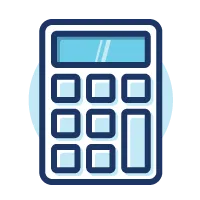We all remember Clark W. Griswold from “National Lampoon’s Christmas Vacation” and the fiasco with his year-end bonus check. To jog your memory, Clark makes an advance payment to build a swimming pool and then instead of receiving his bonus check, he receives a one-year subscription to the jelly of the month club.
Ouch!
Instead of making the same mistake as Clark did, here are ten great things you can do with your year-end bonus check that will have a lasting impact on your life and money.
1. Set Aside Some of It For Fun
Remember, a year-end bonus is extra money you received for all the hard work you put in over the past 12 months. Therefore, it’s important to celebrate your accomplishments by taking a small percentage of your bonus and having a little fun with it!
If you’re looking for that perfect amount to set aside for fun, start with 10%. Depending on the amount of your year-end bonus, this may be a dinner out at a restaurant, a new flat screen TV, or maybe even a vacation.
Whatever you decide, just make sure a portion of your bonus puts a big smile on your face before we move into the “responsible” ways to use the rest of your bonus check.
2. Build Your Emergency Fund
Building your emergency fund definitely doesn’t sound as fun as buying an airline ticket for a beach vacation, but when the next financial emergency comes around, you’ll be so thankful you had cash set aside.
A good rule of thumb is to quickly build a $1,000 starter emergency fund. This first $1,000 is the perfect safety net between you and about 95% of life’s financial disasters. After you set aside that first $1,000, start building a fully funded emergency fund which is typically between three to six months worth of emergency expenses.
To determine how much you’ll need, first identify which expenses would still need to get paid during a financial emergency. These are things that include your rent or mortgage payment, utility bills, groceries, gas for your car, insurance premiums, and anything else that needs to be paid to maintain life during a financial emergency.
After you determine your monthly emergency expenses, multiply that amount by three to six months. Depending on your comfort level and the volatility of your job, you will decide the amount of your emergency fund amount ranging between that three month and six month amount.
Example
A school teacher with a very stable career calculates their monthly emergency expenses to be $2,000. Therefore, a fully funded emergency fund would be between $6,000 and $12,000. In this situation, the school teacher may lean towards a $6,000 emergency fund with the stability of their career.
3. Pay Off Debt
Another great choice when you receive a windfall such as a year-end bonus is to throw as much of it as possible towards your debt.
Just think about how much different life would feel right now if you didn’t have any debt at all. In fact, when you take a moment to add up all of your debt payments, you quickly realize how debt is robbing you of your ability to build wealth.
For example, the average stock market rate of return is about 10% per year for the last 100 years. Compare this to the average credit card interest rate of just over 21% per year, and you can see debt has you paying 21% interest instead of earning 10% interest!
Over the course of a few decades, the difference in earning 10% versus paying over 20% could be the difference in building tremendous wealth for retirement or living below the poverty line in retirement.
The Debt Snowball Method
A proven method to paying off debt as quickly as possible is to use the debt snowball method.
To set up your debt snowball, simply line up all of your non-mortgage debts from smallest to largest balance while also ignoring the interest rates.
Then, make minimum payments on all debts and attack the smallest debt with every extra dollar you can.
After you pay off the first and smallest debt, the payment rolls over or “snowballs” into the next debt on your list. Rinse and repeat this until you’re attacking your last and largest debt with a large monthly payment.
The reason this strategy works so well is that you will pay off that first and smallest debt quickly, which will build motivation for the next debt. After you knock out all of your smaller debts and you reach the largest debt on your list, you’ll have the belief and confidence to pay off that last and final debt for good.
4. Top Off 401(k)
Topping off your 401(k) is another great way to take your year-end bonus and have it go to work for you in the form of wealth building. Take a look at the current amount you have already saved into your employer-sponsored plan and add as much as possible until you reach your contribution limit.
In 2022 the IRS set the 401(k) contribution limit to $20,500 and in 2023, the limit increased to $22,500. Also, keep in mind you will need to make all contributions to your 401(k) plan by December 31st.
If you're 50 or older, you can add an additional $6,500 for 2022 and an additional $7,500 for 2023 into your 401(k) plan.
5. Start a ROTH IRA
A ROTH IRA is another great retirement savings tool because it allows you to save with after-tax dollars. This is important because when it comes time to withdraw your savings in retirement, you won’t have to pay taxes on the withdrawals.
For example, let’s assume you’re in retirement and you have $500,000 in your ROTH IRA and another $500,000 in your 401(k) plan. If you’re currently in the 24% income tax bracket, then withdrawing $500,000 from your 401(k) will incur a tax payment of $120,000. On the other hand, a $500,000 withdrawal from a ROTH IRA will be tax-free!
You have until the tax filing deadline in April to save into your ROTH IRA. This means for the 2022 tax year, you have until April 18, 2023 to make your 2022 ROTH IRA contribution.
The ROTH contribution limits for 2022 are $6,000 or $7,000 if age 50 or older. The contribution limits for 2023 increase to $6,500 or $7,500 if age 50 or older.
6. Invest in Yourself
Another great way to utilize your year-end bonus is to invest in yourself. When thinking about investing in yourself, look at some of your life, health, or career goals and determine where the best place to invest in yourself may be.
For example, if obtaining a certification could boost your career then you could take your year-end bonus and apply it towards tuition for that certification. On the other hand, hiring a health coach this year may be a perfect opportunity to invest in yourself by creating a healthier lifestyle.
Keep in mind that investing in yourself doesn’t necessarily have to result in a monetary return on investment. Is there something you’ve always wanted to learn or do that will increase your overall happiness?
Determine what is most important to you and then apply your year-end bonus to invest into yourself.
7. Add to the 529 Accounts for the Kids
According to Arizona State University, college expenses for a first-year Arizona resident are just over $32,000 per year! The good news is there is a great tax-advantaged savings account to save for college called a 529 plan and it’s also a perfect option for your year-end bonus.
A 529 plan allows you to save money for college with tax-free growth and tax-free withdrawals when used for qualified college expenses. This includes tuition, school fees, books, supplies, computer-related expenses, and even room and board.
And although the contributions to a 529 plan are not tax-deductible, there are over 30 states that currently offer some sort of partial or even full tax-deduction or credit.
Do You Live in Arizona? For those living in Arizona, you can deduct up to $2,000 for single filers and $4,000 for those who are married and filing jointly from your Arizona state income tax.
8. Add to Health Savings Account
A recent CNBC report shows that a 65-year-old couple retiring today can expect to spend around $315,000 in health-care related expenses in retirement!
Thankfully, the IRS has given us all one of the greatest gifts in the form of a Health Savings Account, which just also happens to be a great way to utilize your year-end bonus.
A Health Savings Account (HSA) is a triple tax advantage savings tool to save for health care expenses.
The money you save into your HSA goes in either tax-deferred or tax deductible. Then, the money can be invested inside the HSA and will enjoy tax-free growth. On the back end, when the savings are used for qualified medical expenses, the withdrawals are also tax-free!
To be eligible for a health savings account, you will need to be enrolled in a high-deductible health plan (HDHP). In 2023, the high-deductible health plan must have at least a $1,500 deductible for single filers and $3,000 deductible for those who are married and filing jointly.
9. Save for Big Savings Goal
Are you currently chipping away at a large savings goal? Maybe a down payment for your first home, a once-in-a-lifetime vacation, or for something on your bucket list.
Whatever your big savings goal is, a year-end bonus could be the best option to get you that much closer to reaching your goal. Remember, while you may get a bonus every year it’s still extra money that is coming to you in the form of a windfall. Take that windfall and push your savings goal that much closer to the finish line.
10. Give Some of it Away
The most fun you will ever have with money is by giving some of it away.
What may be just another year-end bonus for you could also be the blessing someone else has been praying for.
When it comes to giving money away, there isn’t a right or wrong way to do it. Whatever is placed on your heart for giving was placed there for a reason. Follow that lead and without any strings attached, simply give some of it away.
What NOT to Do with Your year-end Bonus
Now that we’ve been through the top ten ways to best utilize your year-end bonus, let’s look at some of the biggest mistakes people make when their bonus check comes in.
Do NOT: Use it as Extra Cash
You will definitely want to have a plan for your bonus. If you don’t have a plan right now, then set it all to the side in a savings account and create a plan for it.
The biggest mistake you can make with a year-end bonus is by turning it into extra cash sitting in your checking account. That cash will soon be gone and you’ll be left asking yourself what happened to your year-end bonus and will also have nothing to show for it.
Do NOT: Use it for Down Payment on Big Ticket Item
While it may seem like a great idea, it can also get you into trouble. The reason to avoid a down payment on a big ticket item is because after the down payment comes, so do the monthly payments.
Also, chances are that a big down payment may result in something you really can’t afford and the monthly payments become too much to manage each month. In the end, your year-end bonus goes from a blessing to a nightmare.
Do Not: Gamble It
As the old saying goes, the house always wins.
While it may feel like a good idea to take your bonus check and gamble it to make more money, the chances are too high that in the end you will lose and the gambling industry will win. Remember, casinos are a business and not a charitable organization.
You’re much better off investing into your 401(k), ROTH IRA, or investing in yourself. Gambling is not investing, it’s entertainment and only entertaining if you win.
Do Not: Invest into Something You Don’t Understand
Before you invest into something, ask yourself if you truly understand what you’re investing in, how it works, how you access your investment, and could you explain it to someone else.
In today’s world, there are so many unique things people invest into and oftentimes they make the mistake of not fully understanding what they’re actually investing in. From cryptocurrency, crowdfunded real estate and vintage wine, to art, cannabis, and even comic books — there are a lot of options when it comes to investing.
Before you place your year-end bonus, be certain that you fully understand exactly how it works so you’re actually investing instead of gambling.
Final Thoughts
A year-end bonus is always a blessing and it’s up to you to make certain that year-end bonus remains a blessing. Take a look at the top ten list above and make the decision that is best for where you’re at in life right now. Also, feel free to spread it out over the top ten above if you think that’s best. Maybe some of it tops off your 401(k), some of it goes towards college savings, and the rest is for a mini vacation getaway.
Whatever you choose to do, create a plan for your bonus and then simply follow the plan you created. Best of luck!
Chris “Peach” Petrie is the founder of Money Peach. Money Peach partnered with OneAZ to provide free financial education to members across the state. To learn more about OneAZ’s partnership with Money Peach, click here.
APR = Annual Percentage Rate












